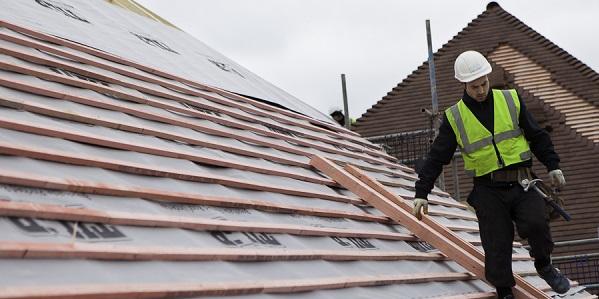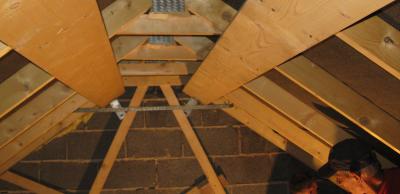Code of practice BS5534 spells changes for roofers
A new code of practice that details design standards, performance and installation of pitched roofs and vertical cladding using slates, tiles, shingles and shakes, as well as their associated components, has been published.
You have until February 2015 to start following the new standards outlined in the new BS5534 Code of Practice: Slating and tiling for pitched roofs and vertical cladding, which was published in August 2014 by the British Standards Institution.
Key changes that will affect you are
- Mortar alone cannot be used to fix ridges and hips. So, even if mortar is used, the ridges and hips must also be mechanically fixed
- Fixing requirements for roof tiles have been increased. All single-lapped tiles on a roof will now have to be mechanically fixed and perimeter tiles must now have a minimum of two fixings
- There will now be a single test for the measurement of the wind uplift resistance of underlays, which all testing bodies will have to comply with.
Ridges and hips - In future you are likely to be asked by building control bodies how you intend to meet these new requirements. Although you do not have to use dry fix systems, you will have to demonstrate how you can effectively fix ridge tiles when using mortar.
Fixing of roof tiles – This needs great care as there are a number of proprietary systems available, but beware as many of them are specific to particular makes of tiles. It will be up to you to demonstrate you have the correct fixings and numbers for the type of tiles you intend to use.
Roofing underlays – They are prone to stretching and ‘ballooning’ under wind load. This can cause the tiles to have greater wind loads applied to them than their design permits. The new standard for underlays will test against this issue. So be sure it has been tested to the new standard and clearly identified as being suitable for the site location and batten gauge in question.
The National Federation of Roofing Contractors (NFRC) is running a series of training courses to help you understand the implications of these changes. Contact Drew Beattie at NFRC for more information.
Sign up to the building bulletin newsletter
Over 48,000 construction professionals have already signed up for the LABC Building Bulletin.
Join them and receive useful tips, practical technical information and industry news by email once every 6 weeks.
Subscribe to the Building Bulletin




Comments
LABC response
Submitted 2 years 9 months ago
Thank you for your query.
Building Regulations does not relate to Planning Permission or vice versa. Compliance would need to be assessed based on the date the work was carried out for the building – not the site – and would be assessed in relation to the regulations and the guidance that was in force at the time of the construction. However, you will need to discuss this with your local authority building control team and you might need to provide evidence to verify the date of construction – otherwise the council might consider the work as being more recent and apply a higher regulatory standard.
Best,
LABC team
Roof insulation
Submitted 2 years 9 months ago
LABC response
Submitted 2 years 9 months ago
Thank you for your query, the advice you have been given in relation to the solar panels needs some clarification as to who provided the advice. As such you should contact a competent person/registered for installation in a building of a system to produce electricity, heat, or cooling, by microgeneration. It would not be possible to comment on the use of foam insulation without a specific site survey as outlined above by a competent installer. These are installers registered with Microgeneration and renewable technologies.
The authorised schemes are by:
APHC
BESCA
Certsure
HETAS
NAPIT
OFTEC
Stroma
Flashing requirements
Submitted 2 years 7 months ago
LABC response
Submitted 2 years 7 months ago
Thank you for your recent enquiry regarding your kitchen extension roof. We are unable to give advice on any particular situation and would not be able to comment on disputes.
Best regards,
LABC team
Ridge tile cement colouring
Submitted 2 years 2 months ago
May I check, I got my ridge tile re-done recently. I got two concerns:
1- The contractor used cement mix without adding dye to it. This is obviously different from the previous ridge tile cement which was colored. Aree you aware about any regulations for adding dye to the ridge tile cement? Is it acceptable practice not to add dye?
2- When they laid the tiles back, they left more space between the tiles and they filled these gaps with cement. That resulted in them having to cut 20 cm out of the last tile so it fit to the roof. Would you think this is risky ?
LABC response
Submitted 2 years 2 months ago
Thank you for your comment
LABC is a membership organisation, providing advice and support to its member local authorities around England and Wales. As a result, LABC cannot comment on the application and enforcement of the Building Regulations on individual cases, as this is a matter for the local council – being the enforcing authority for building regulations.
Responses to your queries are as follows:
1) There is no requirement under the Building Regulations for new mortar to aesthetically match existing. However, if the said works were subject to Planning approval and/or Listed Building Consent, then there may be a need for the new mortar to match the colour and finish of the existing mortar - if this is the case, please contact the Planning Department at the relevant Local Authority. It should be noted that the recommendations contained in BS 5534 are that mortar alone cannot be used to fix ridges.
2) The ridge tiles should be set out and installed in accordance with the manufacturers guidance as it may vary depending on the exact system used. If you are concerned that the manufacturers guidance has not been followed, you may wish to contact their Technical Department for further assistance.
Kind regards,
LABC Team
No bird protection on the valleys, I can put my hand in gaps.
Submitted 2 years 1 month ago
LABC response
Submitted 2 years 1 month ago
Thank you for your query, in terms of valley gutters then it is normal practice to seal these to prevent water ingress and insect or bird ingress. A roofer should follow the standards required of the national federation of roofing contractors. Please see www.nfrc.co.uk
We would also suggest you contact trading standards as this is an issue with the quality of the work carried out by the roofer. Please see www.nationaltradingstandards.uk/contact/
Best,
LABC team
Ychwanegu sylw newydd